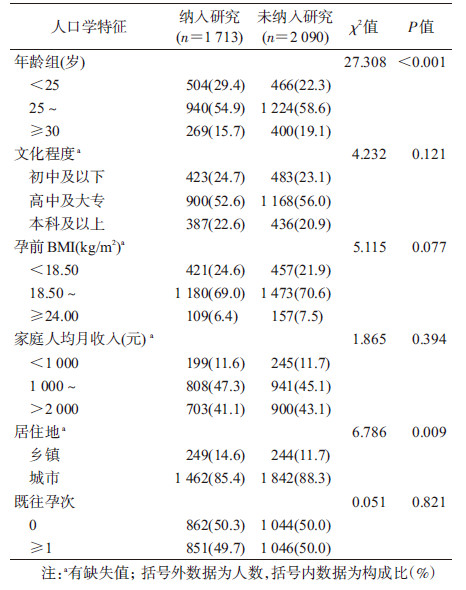文章信息
- 陈星, 鲍慧惠, 吴皖珂, 严双琴, 盛杰, 许媛媛, 顾春丽, 黄锟, 曹慧, 苏普玉, 陶芳标, 郝加虎.
- Chen Xing, Bao Huihui, Wu Wanke, Yan Shuangqin, Sheng Jie, Xu Yuanyuan, Gu Chunli, Huang Kun, Cao Hui, Su Puyu, Tao Fangbiao, Hao Jiahu.
- 孕期双酚A暴露对学龄前儿童情绪和行为问题的影响
- Exposure to bisphenol A during maternal pregnancy and the emotional and behavioral impact on their preschool children
- 中华流行病学杂志, 2018, 39(2): 188-193
- Chinese Journal of Epidemiology, 2018, 39(2): 188-193
- http://dx.doi.org/10.3760/cma.j.issn.0254-6450.2018.02.010
-
文章历史
收稿日期: 2017-06-06
2. 243000 安徽省马鞍山市妇幼保健院;
3. 230032 合肥, 人口健康与优生安徽省重点实验室
2. Ma'anshan Maternal and Child Health Center, Ma'anshan 243000, China;
3. Anhui Provincial Key Laboratory of Population Health and Aristogenics, Hefei 230032, China
双酚A(bisphenol A, BPA)是一种普遍存在的环境内分泌干扰物, 常用于聚碳酸酯塑料和环氧树脂制造, 由于其雌激素样活性和人体长期暴露的高风险, 其近远期健康效应已备受关注。基于对BPA生殖发育毒性的研究, 美国国家毒理部提出重点关注其对胎婴儿和儿童脑发育和行为的影响[1]。目前, 国外越来越多研究表明孕期BPA暴露对儿童神经和行为发育有影响, 且存在性别效应[2-4]。国内该相关课题研究较少, 为此本研究重点探讨母亲孕期BPA暴露与学龄前儿童的情绪和行为问题的关联性。
对象与方法1.研究对象:源自中国安徽出生队列研究(China-Anhui Birth Cohort Study, C-ABCS)的前瞻性随访孕妇人群[5]。C-ABCS孕妇人群系2008年10月至2010年10月在马鞍山市妇幼保健中心建卡且追踪到分娩记录的孕妇。纳入标准为首次来马鞍山市妇幼保健院建立孕产妇保健手册且长期居住本地, 孕周<28周、无神经精神疾病, 能够独立完成孕期相关问卷者。招募孕妇共5 084人, 排除孕期失访、自然流产、死胎、死产、引产及双胎后, 共计随访到4 669名单胎活产儿。2014年4月至2015年6月在马鞍山市各个幼儿园调查随访到单胎儿童3 803人。课题组在2012年12月至2014年1月期间对其中1 783名孕妇的血清测定了BPA。1 783名儿童中, 无采用长处和困难问卷(Strengths and Difficulties Questionnaire, SDQ)结果者70人, 最后纳入研究共计1 713人。所有调查对象及其家长或监护人均签署知情同意书。本研究已通过安徽医科大学伦理委员会的审批。
2.研究方法:
(1) 问卷调查和临床资料收集:由孕妇本人填写课题组编制的《孕产期母婴健康记录表》问卷, 内容包括孕妇基本情况(包括年龄、性别、学历、居住地、孕次等人口统计学指标), 孕前及孕期生活和职业环境暴露情况, 孕期抑郁状况。孕期体检和新生儿分娩基本信息(由产科医生记录在孕产妇保健手册中)。在孕妇首次建卡填写问卷时现场采集血液, 分离其血清, 贮存于-80 ℃冰箱, 再运至安徽医科大学实验室备检。
(2) 儿童随访调查:本研究随访时儿童队列人群年龄3~6岁, 由儿童家长或监护人填写《学龄前儿童健康记录表》, 内容包括人口学指标、母乳喂养情况、疾病史、饮食情况(是否食用膨化食品和饮料)等。
(3) 实验室检测:应用固相萃取-同位素内标-高效液相色谱串联质谱法(HPLC-MS/MS)检测母亲孕期血清中游离的BPA含量[6]。取400 μl血清样本并加入30 ng/ml的BPA内标40 μl, 加入200 μl的2%乙酸酸化, 振荡混匀后进行固相萃取。分别用2 ml甲醇和1 ml水预活化Waters HLB固相萃取柱, 上样后用1 ml 5%的甲醇淋洗除去干扰物, 最后用2 ml甲醇洗脱待测物, 氮气吹干, 200 μl甲醇复溶, 振荡离心后进样待测。BPA的检测限(LOD)为0.15 ng/ml, 定量限(LOQ)为0.40 ng/ml。最后BPA实际浓度为测得样品浓度-同一批次2个质控空白样品平均浓度。
3.诊断标准:①孕妇抑郁症状的评估:采用抑郁自评量表(Center for Epidemiologic Studies Depression, CES-D)[7], 以16分作为临界点, ≥16分为可疑有抑郁症状, <16分为无明显抑郁症状。②儿童情绪和行为问题评估:采用SDQ, 该问卷具有良好的信度和效度[8-10], 共有25个条目, 分成为情绪症状、品行问题、多动/注意力缺陷问题、同伴关系问题、亲社会行为问题共5个因子, 前4个因子得分相加是儿童的整体行为困难总分; 每个因子的得分0~10分分别按照Du等[10]的中国儿童划分标准, 分为正常、边缘和异常。
4.统计学分析:数据双录入采用EpiData 3.0软件, 经核查后运用SPSS 10.0软件进行统计分析。应用χ2检验分析不同社会人口学特征BPA暴露水平的差异和不同特征学龄前儿童情绪和行为问题的分布情况。孕期血清游离BPA浓度按三分位数法分组, 分为低暴露组(≤0.120 ng/ml)、中暴露组(0.120<BPA<0.400 ng/ml)和高暴露组(≥0.400 ng/ml)。本研究中运用多分类logistic回归多因素模型分析孕期BPA暴露与学龄前儿童情绪和行为问题的关联。以学龄前儿童情绪和行为问题为结局变量[正常组=0(对照), 边缘组=1, 异常组=2], 以血清BPA为自变量[低暴露组=3(对照), 中暴露组=2, 高暴露组=1, 运算时以哑变量方式赋值], 控制变量有父母人口学特征(母亲年龄、父母文化程度、居住地、家庭人均月收入、怀孕意愿)、孕早期暴露因素(叶酸补充、二手烟暴露、服用/注射药物、抑郁情况)、儿童的基本情况(出生体重、月龄及饮食情况)。根据数据收集特点以及相关文献选择主要调整因素, 并对可能影响儿童情绪和行为发育的变量进行χ2检验, 将有统计学意义的变量作为控制变量。双侧检验水准α=0.05。
结果1.样本特征:1 713名孕妇年龄19~49(26.55±3.55)岁。其中孕早期1 014例, 孕中期699例, 血清BPA浓度为0.001~20.718 ng/ml。纳入研究者与未被纳入者仅在年龄和居住地方面的差异有统计学意义(表 1)。1 713名儿童中男童908人, 女童805人, 为39~71(52.72±5.17)月龄, 其中情绪症状异常检出率为6.48%(111/1 713), 品行问题异常检出率为8.11%(139/1 713), 多动/注意缺陷异常检出率为8.35%(143/1 713), 同伴交往异常检出率为2.86%(49/1 713), 亲社会行为问题异常检出率为11.38%(195/1 713), 困难总分异常检出率为7.94%(136/1 713)。
2.不同社会人口学特征者BPA暴露分布:研究对象按照血清BPA浓度三分位数法分为低暴露组、中暴露组和高暴露组, 人口学特征方面, 3组之间仅在家庭人均月收入的差异有统计学意义(表 2)。
3.儿童情绪和行为问题异常影响因素分析:经过单因素χ2检验, 学龄前儿童情绪和行为问题异常与母亲年龄、父母文化程度、家庭人均月收入、居住地、怀孕意愿、孕早期叶酸补充、孕早期抑郁、孕早期二手烟暴露、孕早期服用/注射药物、儿童出生体重、月龄和饮食情况的差异有统计学意义(P<0.05)。见表 3。
4.母亲孕期BPA暴露与学龄前儿童情绪和行为问题的关联:血清BPA暴露与学龄前儿童情绪和行为问题病因关联的单因素logistic回归分析结果显示, 母亲孕期BPA高暴露组儿童在品行问题方面异常发生风险是低暴露组的1.838(95%CI:1.193~2.831)倍。多因素logistic回归模型结果显示, 母亲孕期BPA高暴露水平是儿童品行问题的危险因素(OR=1.876, 95%CI:1.161~3.029, P=0.010)。孕期BPA暴露水平在其他情绪和行为问题方面的差异均无统计学意义(表 4)。通过计算得出方差膨胀因子<5, 容许值>0.1, 条件指数<100, 因此变量间不存在共线性。进一步分析母亲孕期BPA暴露与学龄前儿童品行问题关联的性别效应, 将儿童按性别分组后的多因素logistic回归模型显示, 母亲孕期高水平BPA暴露对学龄前儿童品行问题异常发生风险存在性别效应, 且男童表现得更为明显(表 5)。
孕期BPA暴露与儿童情绪和行为发育有关。本研究结果显示, 与母亲低水平血清BPA的儿童相比, 高水平血清BPA浓度的儿童品行问题异常发生风险是前者的1.876倍。
先前的队列研究均表明高水平BPA暴露增加儿童情绪行为问题的发生[11]。但检测的生物样本、儿童年龄的差异以及采用不同的儿童情绪和行为问题评估量表可造成研究结果存在差异。如Perera等[12-14]基于哥伦比亚儿童环境健康中心城市出生队列的研究先后发现, 孕期高水平尿液BPA浓度暴露, 使3~5岁男童情绪反应和攻击行为增加(采用Achenbach儿童行为量表), 7~9岁的男童内、外化行为增多, 10~12岁男童的焦虑和抑郁症状(采用修订儿童焦虑量表和儿童抑郁量表)明显, 女童中未发现这种相关性。Stacy等[15]研究显示产前高水平BPA浓度可增加8岁女童的外化行为(采用BASC-2), 男童中无此关联。
孕期BPA暴露对子代神经和行为发育影响的具体机制尚不明确, 可能的机制有表观遗传学修饰, 基因组与非基因组效应, 以及突触数量和可塑性改变等[16]。此外, 下丘脑-垂体-肾上腺轴(hypothalamic-pituitary-adrenal axis, HPA轴)是重要的神经内分泌系统反馈调节机制, BPA暴露会影响子代HPA轴的正常生理功能[17-18], 如Panagiotidou等[19]研究围产期低剂量BPA暴露对HPA轴功能的影响, 结果发现BPA暴露导致子代小鼠肾上腺组织学异常, 并干扰HPA轴基线及应激诱导活性, 增加后期生命中应激相关障碍发生的易感性。最新的人群流行病学研究发现孕期BPA暴露与HPA轴功能紊乱有关[20-21], 并提出HPA轴功能改变介导BPA暴露致儿童性别特异性影响的假说。
综上所述, 孕期高水平BPA暴露可以使学龄前儿童品行问题异常的发生风险增加。但本研究评估个体的BPA暴露情况基于单一样本血清BPA浓度检测; 样本人群来自马鞍山市, 所得的研究结论在某种程度上不具有推广性; 研究设计未评估儿童的生活环境和家庭教养情况, 在控制儿童出生后其他暴露因素对其情绪和行为的影响存在一定局限性。
利益冲突: 无
| [1] | Chapin RE, Adams J, Boekelheide K, et al. NTP-CERHR expert panel report on the reproductive and developmental toxicity of bisphenol A[J]. Birth Defects Res B Dev Reprod Toxicol, 2008, 83(3): 157–395. DOI:10.1002/bdrb.20147 |
| [2] | Harley KG, Gunier RB, Kogut K, et al. Prenatal and early childhood bisphenol A concentrations and behavior in school-aged children[J]. Environ Res, 2013, 126: 43–50. DOI:10.1016/j.envres.2013.06.004 |
| [3] | Evans SF, Kobrosly RW, Barrett ES, et al. Prenatal bisphenol A exposure and maternally reported behavior in boys and girls[J]. Neurotoxicology, 2014, 45: 91–99. DOI:10.1016/j.neuro.2014.10.003 |
| [4] | Braun JM, Muckle G, Arbuckle T, et al. Associations of prenatal urinary bisphenol A concentrations with child behaviors and cognitive abilities[J]. Environ Health Perspect, 2017, 125(6): 067008. DOI:10.1289/EHP984 |
| [5] | Tao FB, Hao JH, Huang K, et al. Cohort Profile:the China-Anhui birth cohort study[J]. Int J Epidemiol, 2013, 42(3): 709–721. DOI:10.1093/ije/dys085 |
| [6] |
鲍慧惠, 盛杰, 许媛媛, 等. 血清中游离型双酚A的固相萃取-同位素内标-高效液相色谱串联质谱测定法[J]. 环境与健康杂志, 2014, 31(1): 44–46.
Bao HH, Sheng J, Xu YY, et al. Determination of bisphenol A in serum by high-performance liquid chromatography-tandem mass spectrometry[J]. J Environ Health, 2014, 31(1): 44–46. |
| [7] | Goodman R. Psychometric properties of the strengths and difficulties questionnaire[J]. J Am Acad Child Adolesc Psych, 2001, 40(11): 1337–1345. DOI:10.1097/00004583-200111000-00015 |
| [8] | Dickey WC, Blumberg SJ. Revisiting the factor structure of the strengths and difficulties questionnaire:United States, 2001[J]. J Am Acad Child Adolesc Psych, 2004, 43(9): 1159–1167. DOI:10.1097/01.chi.0000132808.36708.a9 |
| [9] | Goodman R, Ford T, Simmons H, et al. Using the Strengths and Difficulties Questionnaire(SDQ) to screen for child psychiatric disorders in a community sample[J]. Int Rev Psych, 2003, 15(1/2): 166–172. DOI:10.1080/0954026021000046128 |
| [10] | Du YS, Kou JH, Coghill D. The validity, reliability and normative scores of the parent, teacher and self report versions of the Strengths and Difficulties Questionnaire in China[J]. Child Adolesc Psych Ment Health, 2008, 2(1): 8. DOI:10.1186/1753-2000-2-8 |
| [11] | Ejaredar M, Lee Y, Roberts DJ, et al. Bisphenol A exposure and children's behavior:A systematic review[J]. J Expo Sci Environ Epidemiol, 2017, 27(2): 175–183. DOI:10.1038/jes.2016.8 |
| [12] | Perera F, Vishnevetsky J, Herbstman JB, et al. Prenatal bisphenol a exposure and child behavior in an inner-city cohort[J]. Environ Health Perspect, 2012, 120(8): 1190–1194. DOI:10.1289/ehp.1104492 |
| [13] | Roen EL, Wang Y, Calafat AM, et al. Bisphenol A exposure and behavioral problems among inner city children at 7-9 years of age[J]. Environ Res, 2015, 142: 739–745. DOI:10.1016/j.envres.2015.01.014 |
| [14] | Perera F, Nolte ELR, Wang Y, et al. Bisphenol A exposure and symptoms of anxiety and depression among inner city children at 10-12 years of age[J]. Environ Res, 2016, 151: 195–202. DOI:10.1016/j.envres.2016.07.028 |
| [15] | Stacy SL, Papandonatos GD, Calafat AM, et al. Early life bisphenol A exposure and neurobehavior at 8 years of age:identifying windows of heightened vulnerability[J]. Environ Int, 2017, 107: 258–265. DOI:10.1016/j.envint.2017.07.021 |
| [16] |
牛影, 郝加虎, 苏普玉, 等. 孕期双酚A暴露致子代心理行为发育改变的相关机制研究进展[J]. 卫生研究, 2015, 44(3): 506–510.
Niu Y, Hao JH, Su PY, et al. Advances on impact of prenatal exposure to bisphenol A on psychological and behavioral development in offspring and its related mechanisms[J]. J Hyg Res, 2015, 44(3): 506–510. |
| [17] | Poimenova A, Markaki E, Rahiotis C, et al. Corticosterone-regulated actions in the rat brain are affected by perinatal exposure to low dose of bisphenol A[J]. Neuroscience, 2010, 167(3): 741–749. DOI:10.1016/j.neuroscience.2010.02.051 |
| [18] | Chen F, Zhou LB, Bai YY, et al. Hypothalamipituitary-adrenal axis hyperactivity accounts for anxiety-and depression-like behaviors in rats perinatally exposed to bisphenol A[J]. J Biomed Res, 2015, 29(3): 250–258. DOI:10.7555/JBR.29.20140058 |
| [19] | Panagiotidou E, Zerva S, Mitsiou DJ, et al. Perinatal exposure to low-dose bisphenol A affects the neuroendocrine stress response in rats[J]. J Endocrinol, 2014, 220(3): 207–218. DOI:10.1530/JOE-13-0416 |
| [20] | Giesbrecht GF, Liu JY, Ejaredar M, et al. Urinary bisphenol A is associated with dysregulation of HPA-axis function in pregnant women:findings from the APrON cohort study[J]. Environ Res, 2016, 151: 689–697. DOI:10.1016/j.envres.2016.09.007 |
| [21] | Giesbrecht GF, Ejaredar M, Liu JY, et al. Prenatal bisphenol a exposure and dysregulation of infant hypothalamic-pituitary-adrenal axis function:findings from the APrON cohort study[J]. Environ Health, 2017, 16(1): 47. DOI:10.1186/s12940-017-0259-8 |
 2018, Vol. 39
2018, Vol. 39







